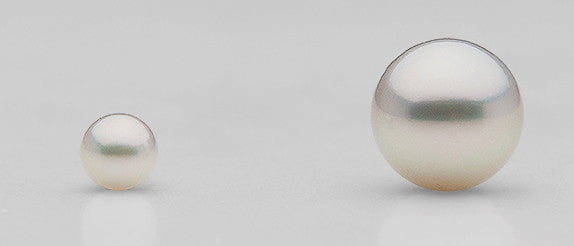We're often asked for advice when customers are trying to determine what size of pearl is best suited for them. The question is typically whether or not it is worth it to go up a size or two in millimeters. Is the difference really that noticeable?
The image below is of a 6 mm akoya pearl next to a 12 mm South Sea pearl. The millimeter size is exactly double, but it's easy to see that the true difference in size is much greater.
6 mm akoya pearl next to 12 mm South Sea pearl
As a rule of thumb, I've always told customers that a 2 mm incremental increase in millimeter size would approximately double the overall size of the pearl. On the surface this tends to be confusing. How can an 8 mm pearl be twice the size of a 6 mm pearl?
Pearl Dreams, a pearl enthusiast from Pearl-Guide.com's community forum produced a brilliant explanation that I plan to incorporate into our team training. It isn't so much the millimeter size that determines the true size of a pearl. Given that pearls are three-dimensional objects, the volume is what truly determines the size.
By determining the volume of perfectly round pearls (V = ⁴⁄₃πr³) in 1 mm pearl increments, Pearl Dreams was able to show that a small increase in pearl mm size can have a large impact on the true size of a pearl.
12 mm pearl: 904 cubic mm (30% larger than 11mm and 73% larger than 10mm; over 3 times as large as 8mm)
11 mm pearl: 697 cubic mm (33% larger than 10mm)
10 mm pearl: 523 cubic mm (37% larger than 9mm, 95% larger than 8mm)
9 mm pearl: 382 cubic mm (43% larger than 8mm; 2 times as large as 7mm pearls)
8 mm pearl: 268 cubic mm (49% larger than 7mm)
7 mm pearl: 180 cubic mm (59% larger than 6mm)
6 mm pearl: 113 cubic mm
Pearl Dreams went on to describe a formula to determine the volume for a prolate ellipsoid, which can be related to oval pearls.
This is likely the best explanation I've ever seen on this subject.







